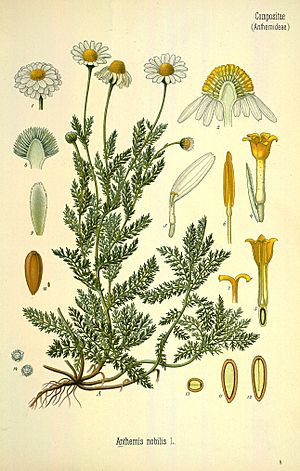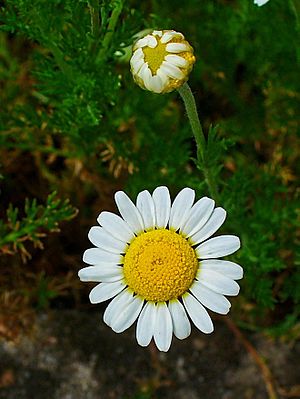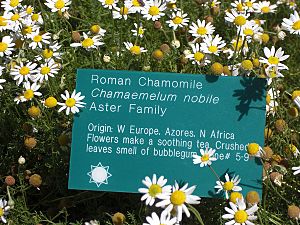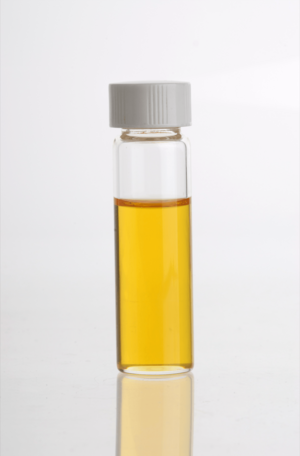Roman Chamomile facts for kids
Quick facts for kids Chamomile |
|
|---|---|
 |
|
| Chamaemelum nobile | |
| Conservation status | |
| Scientific classification | |
| Synonyms | |
|
Anthemis nobilis L. |
Chamaemelum nobile, often called chamomile (or camomile), is a small plant that lives for many years. You can find it in dry fields, gardens, and farmed areas in Europe, North America, and South America. It's also known by other names like Roman chamomile, English chamomile, garden chamomile, or ground apple.
People use C. nobile to make a herbal product. They dry its flowers to add flavor to teas or to create a nice smell for aromatherapy. Aromatherapy is a practice that uses plant extracts for well-being. While chamomile is popular, scientists haven't proven it has specific medical benefits.
Contents
What Does Chamomile Look Like?
Chamaemelum nobile has white flowers that look like daisies. Its stems grow along the ground. The leaves are arranged in a special way and are very finely cut, feeling soft or smooth.
The plant has single flowers at the very top of its stems. These flowers stand about 20 to 30 centimeters (8 to 12 inches) above the ground. Each flower has bright yellow centers and shiny white petals. In the Northern Hemisphere, chamomile flowers bloom in June and July. They have a sweet, fresh, fruity, and earthy smell. Even though it looks similar, this plant is different from German chamomile (Matricaria chamomilla). They have different shapes, uses, and chemical makeup.
Where Did the Name Chamomile Come From?
The name "chamomile" and the plant's scientific name, Chamaemelum, come from ancient Greek words. The Greek word "chamaimēlon" means "earth-apple." This is because "chamai" means "on the ground" and "mēlon" means "apple." People called it this because the plant smells a bit like apples.
The plant got the name "nobile," which is Latin for "noble," because people thought it had better healing powers than German chamomile.
A Look Back: Chamomile's History
Roman chamomile (C. nobile) has been used in traditional medicine since the Middle Ages. This means people have used it for health reasons for a very long time. Growing the plant in Europe started in England in the 1500s.
It was first listed in a German book of medicines as a plant that could help with gas, pain, and digestion. A person named Joachim Camerarius was the first to find and name chamaemelum nobile in Rome in 1598. In ancient Egypt, chamaemelum nobile was a symbol of respect for their gods.
Saving Chamomile: Conservation Efforts
Chamaemelum nobile is currently listed as "least concern" on the IUCN Red List. This list tells us about the risk of plants and animals disappearing. However, the number of these plants in the UK is going down quite a lot.
This decline is happening because wet grasslands are being drained, there's less grazing by animals, and pastures are being turned into farms. Some people also think that collecting wild plants might be causing the population to shrink.
Even though the plant numbers are decreasing, some Chamaemelum nobile plants are protected in special land and water areas. There are no big programs to teach people about this plant, or international rules to protect it worldwide.
How People Use Chamomile
People use parts of Chamaemelum nobile, like its dried flowers or extracts, in products for hair care and skincare. The plant can also be used to flavor foods, make herbal teas, perfumes, and cosmetics.
In aromatherapy, some believe it helps calm people, reduce stress, and help with sleep. Chamomile essential oil contains special natural chemicals that give it its smell. These can be taken out separately.
You can even use chamomile to create a sweet-smelling lawn! A chamomile lawn needs light soil, enough water, and sunshine to grow well. About 83 to 100 plants are needed for every square meter. This type of lawn is best for light walking or in areas where it's hard to use a lawnmower.
Traditional Uses and Things to Know
Even though chamomile is used in folk medicine, there is no strong scientific proof that it has any medical uses. In Germany, some alternative medicine practices suggest using chamomile on the skin or breathing it in for mouth and breathing passage irritations.
It's probably not safe to use chamomile during pregnancy. Also, putting it on your skin might cause a rash for some people. There are no known problems when chamomile is used with common medicines. However, drinking chamomile tea might affect how some blood-thinning medicines work.
Other Names for Chamomile
This plant has many different common names. In the 21st century, "Roman chamomile" or "sweet chamomile" are often used.
See also
 In Spanish: Manzanilla común para niños
In Spanish: Manzanilla común para niños





